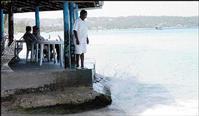
The famous seven-mile Negril Beach which is taking a severe beating from erosion.
-Patrick Campbell photo
Erica James-King, Staff Reporter
WESTERN BUREAU:
NEGRIL'S FAMOUS seven-mile white sand beach is eroding fast and oceanographic experts are blaming the resort town's poor central sewerage system as the main culprit.
Scientists from the Harbour Branch Oceanographic Institute in Florida and the Negril Coral Reef Preservation Society (NCRPS) are contending that while the Negril sewerage system has been rated favourably in terms of reducing health threats to users of the ocean, it is a very destructive force to the seven-mile beach. Both groups feel that in the last decade, at least 80 feet of the Negril Beach has been lost to erosion.
AGRICULTURAL RUN-OFF
The cumulative picture they say, could amount to up to 400 feet of sand being lost in the last 20 years because of the effects of pollution by sewage and agricultural run-off, damage to the reefs by water sports and, to a lesser extent, overfishing.
They've identified three main problems associated with the erosion. They believe that little or no beach sand is being produced because the reef is dying at a rapid rate; corals have decreased dramatically so they can't protect Negril's beaches (especially in the Long Bay area) from increased erosional forces, and reef health in Negril continues to decline. That they say, signals that the loss of the beach will continue, as reefs become smothered by algae.
Dr. Bryan Lapointe, senior
scientist with Harbour Branch Oceanographic Institute who has been monitoring corals and seaweed and collecting and analysing water quality samples in the South and North Negril rivers, as well as the sea in that resort area, said the sewage ponds are leaching a high level of phosphorous and nitrogen like ammonia into the river and eventually into the sea.
"This nutrient pollution or nutrification is killing the reefs," he said. "So Negril's beach erosion problem is really bound-up with a reef-health problem."
BAD NEWS
This is bad news as scientific studies are showing that Negril only has five per cent live coral-cover on its shallow reefs, and 10 per cent live coral cover on its deep reefs.
Dr. Lapointe points out that a re-examination of the reefs at the Yacht Club, Rockhouse, Lighthouse and Ironshore in Negril over the past few years is showing an increasingly negative impact of sewage pollution on those reefs.
According to Dr. Lapointe, over the last seven years, water samples taken and analysed by his Oceanographic Institute as well as the NCRPS have shown that the stable nitrogen isotopes values (a method of measuring nitrates) in the water at the shallow and deep reefs and at the westend, has increased significantly since the central sewerage system came into being.
Since the sewage was diverted to the ponds, concentrations of ammonium and phosphorus increased dramatically in the South Negril River, as a result of the overflow from the sewage ponds, complained Dr. Lapointe.
Outlining the negative impact of the high concentrations of phosphates and nitrates getting into the water, Dr. Lapointe said "Owing to nutrient pollution, what we think has happened is that we have seen a decrease in recent years, in the production of new beach sand."
Before the Negril sewerage system was constructed in 1998, some residents there had questioned the proposed design of the system.
DESIGN
"We wanted those in authority at that time to change the designs to a thorough treatment system, but they insisted on going ahead with just diverting the sewage to sewage ponds. They didn't listen to us and now the beach is taking a beating from that system," noted Jean Brown of the NCRPS yesterday.
One area of disquiet for the NCRPS is that corals like the Elkhorn corals (the outward branching corals) can no longer protect the beach especially the Long Bay area of Negril from severe erosion by storm waves, because the corals are dying fast.
In the meantime, the National Water Commission is in no hurry to revamp the Negril sewerage system. The agency says it "currently has no plans" on the table for adjustments to the system.
"You tend to get higher nitrates and phosphate concentrations from a sewage pond, but the sewage ponds are doing what they are designed to do," said Lisa Golding, community relations manager for the Western Division in response to questions from The Sunday Gleaner. "The sewage ponds are not about treating nitrates and phosphates, it is about the biological breakdown of bacteria. So the Negril sewage ponds are protecting the water quality by reducing the risk of water borne diseases."
She says however, there are ongoing discussions between her company and the Negril community on the concerns that the ponds pose to the reefs, but mechanical treatment of the sewage is not on the cards at this time.












